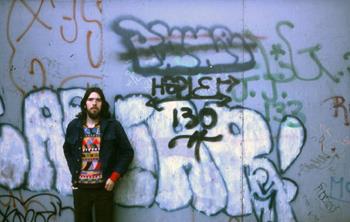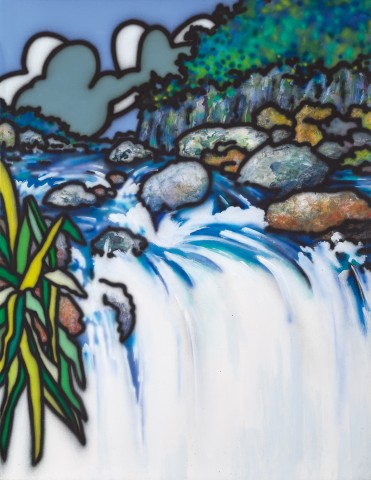WATERFALL 2, 1988
HOWARD ARKLEY
synthetic polymer paint on canvas
175.5 x 135.5 cm
signed, dated and inscribed with title verso: Howard Arkley / Waterfall. 2. / 1988
Tolarno Galleries, Melbourne (label attached verso)
The National Australia Bank Art Collection, acquired from the above in December 1988 (label attached verso)
The National Australia Bank Art Collection: Rivers in Australian Art, Heide Park and Art Gallery, Melbourne, October 1991
Australian Art: Colonial to Contemporary, Deutscher Fine Art, Melbourne, May – June 1995, cat. 111 (illus. in exhibition catalogue, p. 84)
The National Australia Bank Art Collection: Rivers in Australian Art, Heide Park and Art Gallery, Melbourne, 1991, p. 16 (illus.)
Simmonds, D., 'New & Notable: Which Bank', The Bulletin, Sydney, 15 November 1991, p. 21 (illus.)
Howard Arkley Online Catalogue Raisonné: [https://www.arkleyworks.com/blog/2009/11/21/waterfall-2-1988/] (accessed 7/06/21)
210733.jpg

The year 1988 was a significant one for Howard Arkley, as he experienced the critical and financial success of his first major exhibition solely devoted to his paintings of suburban houses, Howard Arkley: Recent Paintings – Houses & Homes at Tolarno Galleries, Melbourne. With their areas of high-keyed colour and black airbrushed outlines, and with subjects ranging from established middle class houses to inner-city flats and newer dwellings from the city’s outer suburbs1, these are the works that came to signal the artist’s signature style, along with his public identification as painter of ‘the so-called “suburban dreaming”’.2 This exhibition also introduced the first of Arkley’s Shadow Factories series (1988 – 90), whose smoke-filled skies filled from the towers of industrial buildings share a similar treatment to the airbrushed cloud forms in Waterfall 2, 1988 – while of course being far less bucolic in nature.
Waterfall 2 was commissioned by Arkley’s gallerist Georges Mora, who was engaged as a consultant for the National Australia Bank on the development of the collection. Mora encouraged Arkley, along with other artists, to produce a large-scale canvas on the subject of ‘the river’, which was a central theme of many of the works acquired between 1988 and 1993.3 However, true to form, Arkley deviated from this suggestion and did his own thing.
While atypical in subject matter, Waterfall 2 is classic Arkley, with its combination of flat blocks of colour and painterly passages and its confident airbrushed lines. The work also conveys the artist’s deft combination of brushwork and patterning, which is more often characteristically ascribed in his practice to surface interiors or the exterior of buildings. Waterfall 2 captures Arkley’s skill as a technician, with passages of paint used to provide shape and texture to rock forms and the rush of water as it cascades down the waterfall. Here, rather than embodying the ‘zing’ and orchestrated excess of Arkley’s usual combination of colour and decoration, the artist uses airbrushed dots to evoke the dappled light and gentle movement of foliage in the natural environment.
The landscape was neither Arkley’s natural habitat nor subject of choice and it is perhaps not surprising to learn that the artist was challenged by the realisation of this work, producing ‘an unusually extensive quantity of preparatory material’4 for it, indicative of his struggle. Interestingly, despite this painting being titled Waterfall 2, no evidence has been found of a previous version. As Arkley remarked to Richard Brown the year after the painting was made: ‘The subjects that I choose are very impersonal… It’s all about the Australian suppressed experience in the suburbs… It wouldn’t be appropriate to go out and do rural landscape painting using this approach, I’ve tried and it doesn’t work very well’.5 Yet despite Arkley’s discomfort with this subject matter and his execution of it, he nevertheless created, in the contested year of Australia’s Bicentenary, a powerful evocation of a tranquil outdoor scene which adroitly sidesteps the nationalistic rhetoric that can often accompany depictions of the Australian landscape.
1. See Arkley Works: https://www.arkleyworks.com/blog/2009/11/21/howard-arkley-recent-paintin... (viewed 15 December 2021)
2. Gregory, J., Carnival in Suburbia: The Art of Howard Arkley, Cambridge University Press, New York, 2006, p. 1
3. This aspect of the collection was showcased in 1991 in the exhibition National Australia Bank Collection: Rivers in Australian Art at Heide Park and Art Gallery (now Heide Museum of Modern Art)
4. See Arkley Works: https://www.arkleyworks.com/blog/2009/11/21/waterfall-2-1988/
5. Brown, R., ‘Spraying the Suburban Dream: Howard Arkley’, Tension, 18, 1989, p. 39
KELLY GELLATLY
